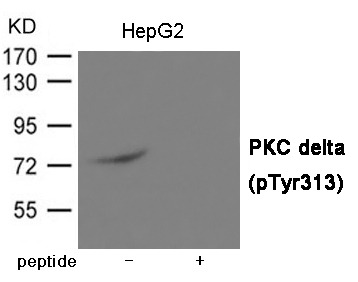购物车
全部删除  您的购物车当前为空
您的购物车当前为空
别名 PRKCD (p-Y313), PRKCD (p-Tyr313), p-PRKCD (Y313), p-PRKCD (Tyr313)
Anti-Phospho-PRKCD (Tyr313) Polyclonal Antibody 是一种 Rabbit 抗体,靶向 Phospho-PRKCD (Tyr313)。Anti-Phospho-PRKCD (Tyr313) Polyclonal Antibody 可用于 WB。
Anti-Phospho-PRKCD (Tyr313) Polyclonal Antibody 是一种 Rabbit 抗体,靶向 Phospho-PRKCD (Tyr313)。Anti-Phospho-PRKCD (Tyr313) Polyclonal Antibody 可用于 WB。
| 规格 | 价格 | 库存 | 数量 |
|---|---|---|---|
| 50 μL | ¥ 1,495 | 5日内发货 | |
| 100 μL | ¥ 2,240 | 5日内发货 |
| 产品描述 | Anti-Phospho-PRKCD (Tyr313) Polyclonal Antibody is a Rabbit antibody targeting Phospho-PRKCD (Tyr313). Anti-Phospho-PRKCD (Tyr313) Polyclonal Antibody can be used in WB. |
| 别名 | PRKCD (p-Y313), PRKCD (p-Tyr313), p-PRKCD (Y313), p-PRKCD (Tyr313) |
| Ig Type | IgG |
| 交叉反应 | Human |
| 验证活性 | 1. Western blot analysis of extracts from HepG2 cells using PKC delta (Phospho-Tyr313) Antibody TMAC-03315. The lane on the right is treated with the antigen-specific peptide.  |
| 应用 | WB |
| 抗体种类 | Polyclonal |
| 宿主来源 | Rabbit |
| 构建方式 | Polyclonal Antibody |
| 纯化方式 | Antibodies were produced by immunizing rabbits with synthetic phosphopeptide and KLH conjugates. Antibodies were purified by affinity-chromatography using epitope-specific phosphopeptide. Non-phospho specific antibodies were removed by chromatogramphy using non-phosphopeptide. |
| 性状 | Liquid |
| 缓冲液 | Supplied at 1.0mg/mL in phosphate buffered saline (without Mg2+ and Ca2+), pH 7.4, 150mM NaCl, 0.02% sodium azide and 50% glycerol. |
| 研究背景 | Calcium-independent, phospholipid- and diacylglycerol (DAG)-dependent serine/threonine-protein kinase that plays contrasting roles in cell death and cell survival by functioning as a pro-apoptotic protein during DNA damage-induced apoptosis, but acting as an apoptotic protein during cytokine receptor-initiated cell death, is involved in tumor suppression as well as survival of several cancers, is required for oxygen radical production by NADPH oxidase and acts as positive or negative regulator in platelet functional responses. Upon DNA damage, activates the promoter of the death-promoting transcription factor BCLAF1/Btf to trigger BCLAF1-mediated p53/TP53 gene transcription and apoptosis. In response to oxidative stress, interact with and activate CHUK/IKKA in the nucleus, causing the phosphorylation of p53/TP53. In the case of ER stress or DNA damage-induced apoptosis, can form a complex with the tyrosine-protein kinase ABL1 which trigger apoptosis independently of p53/TP53. In cytosol can trigger apoptosis by activating MAPK11 or MAPK14, inhibiting AKT1 and decreasing the level of X-linked inhibitor of apoptosis protein (XIAP), whereas in nucleus induces apoptosis via the activation of MAPK8 or MAPK9. Upon ionizing radiation treatment, is required for the activation of the apoptosis regulators BAX and BAK, which trigger the mitochondrial cell death pathway. Can phosphorylate MCL1 and target it for degradation which is sufficient to trigger for BAX activation and apoptosis. Is required for the control of cell cycle progression both at G1/S and G2/M phases. Mediates phorbol 12-myristate 13-acetate (PMA)-induced inhibition of cell cycle progression at G1/S phase by up-regulating the CDK inhibitor CDKN1A/p21 and inhibiting the cyclin CCNA2 promoter activity. In response to UV irradiation can phosphorylate CDK1, which is important for the G2/M DNA damage checkpoint activation. Can protect glioma cells from the apoptosis induced by TNFSF10/TRAIL, probably by inducing increased phosphorylation and subsequent activation of AKT1. Is highly expressed in a number of cancer cells and promotes cell survival and resistance against chemotherapeutic drugs by inducing cyclin D1 (CCND1) and hyperphosphorylation of RB1, and via several pro-survival pathways, including NF-kappa-B, AKT1 and MAPK1/3 (ERK1/2). Can also act as tumor suppressor upon mitogenic stimulation with PMA or TPA. In N-formyl-methionyl-leucyl-phenylalanine (fMLP)-treated cells, is required for NCF1 (p47-phox) phosphorylation and activation of NADPH oxidase activity, and regulates TNF-elicited superoxide anion production in neutrophils, by direct phosphorylation and activation of NCF1 or indirectly through MAPK1/3 (ERK1/2) signaling pathways. May also play a role in the regulation of NADPH oxidase activity in eosinophil after stimulation with IL5, leukotriene B4 or PMA. In collagen-induced platelet aggregation, acts a negative regulator of filopodia formation and actin polymerization by interacting with and negatively regulating VASP phosphorylation. Downstream of PAR1, PAR4 and CD36/GP4 receptors, regulates differentially platelet dense granule secretion; acts as a positive regulator in PAR-mediated granule secretion, whereas it negatively regulates CD36/GP4-mediated granule release. Phosphorylates MUC1 in the C-terminal and regulates the interaction between MUC1 and beta-catenin. The catalytic subunit phosphorylates 14-3-3 proteins (YWHAB, YWHAZ and YWHAH) in a sphingosine-dependent fashion. |
| 偶联 | Unconjugated |
| 其他可选修饰符 | Phospho |
| 免疫原 | Peptide sequence around phosphorylation site of Tyrosine 313 (G-I-Y(p)-Q-G) derived from Human PKC delta |
| 抗原种属 | human |
| Uniprot ID |
| 分子量 | Actual: 78 kDa. |
| 储存方式 | Store at -20°C or -80°C for 12 months. Avoid repeated freeze-thaw cycles. |
| 运输方式 | Shipping with blue ice. |
评论内容